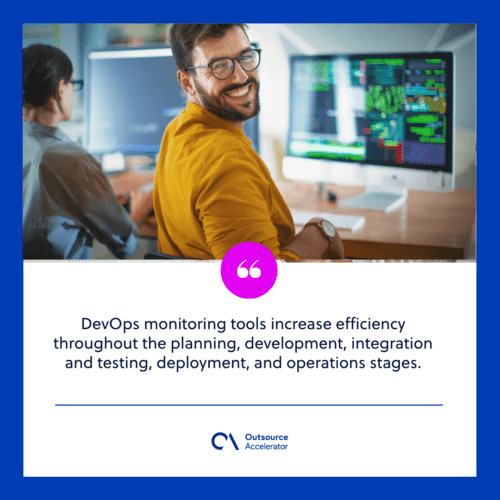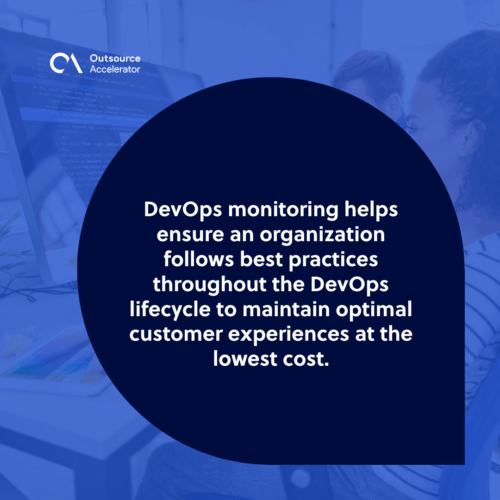Top 20 DevOps monitoring tools for continuous monitoring

Top 20 DevOps monitoring tools
- SVN
- SignalFx
- Middleware
- Jenkins
- Selenium
- Docker
- Git
- Ansible
- Puppet
- Chef
- Apache Ant
- Maven
- Kubernetes
- Rational ClearCase
- Catchpoint
- Splunk On-Call
- Raygun
- Splunk Cloud
- Prometheus
- Gremlin
What is DevOps monitoring?
DevOps monitoring has emerged as outstanding software development and deployment approach that enables DevOps teams to improve through continuous monitoring (CM).[1]
DevOps monitoring allows teams to locate potential errors before releasing the code to production. This increases the overall development efficiency of continuous monitoring.
DevOps monitoring solutions enable automation and improved measurement and visibility across the software development lifecycle.[2]
DevOps monitoring tools increase efficiency throughout the planning, development, integration and testing, deployment, and operations stages.

Importance of DevOps
DevOps monitoring is important because it helps with the following:
Enhance customer response time
It enables teams to quickly and automatically respond to any concerns in the customer experience.
Continuous monitoring that assists DevOps teams in initiating prompt responses and application performance monitoring to all types of application issues avoids unexpected outages.
Detection and prevention of defects
DevOps performs shift-left testing to help improve quality, shorten test cycles, and reduce errors. As a result, defects are found and prevented early in the software development process.
Supports team collaboration
Utilizing DevOps monitoring tools can create a continuous feedback loop that improves operations teams’ capabilities, users, and the rest of the organization.
DevOps monitoring tools facilitate the quicker creation of new products and the simpler maintenance of existing deployments with the help of advanced data analysis tools.
Overall, DevOps monitoring helps ensure an organization follows best practices throughout the DevOps lifecycle to maintain optimal customer experiences at the lowest cost.

Top 20 DevOps monitoring tools
Because software development involves frequent code changes, it is a requirement to use DevOps monitoring. This offers a real-time and complete picture of the production environment and helps in analyzing machine-generated data.
You’ll need the best DevOps monitoring to achieve quality products with minimal costs while effectively monitoring application and network performance.
Here we have the top DevOps monitoring tools:
1. SVN
Subversion (SVN) is a centralized open-source system. Every time a team member or client wants to make changes in the code, the person in charge has to inform the central server or repo about these changes.
SVN was originally designed as a command line interface. This means you would open your terminal and type commands.
For Subversion to work, the SVN setup needs these two elements:
Server – which has all versions of source files
Local copy of the files – which is on your computer
Here are the steps to use the SVN repo:
To use an SVN repository, the client must first establish a connection with the main server. It may check out the code to download the repository from the server.
Second, the client then moves on to make changes in this code and commits these changes by informing the central repo.
Lastly, these changes will be visible to other team members or clients from the central repo.
2. SignalFx
SignalFx is a DevOps monitoring tool that Splunk has just acquired. It can get traces, metrics, and events from applications and infrastructure to quickly fix problems.
SignalFx is great for debugging and post-incident reviews through high cardinality analytics, service mapping, and detailed visualizations and dashboards.
3. Middleware
Middleware is a powerful DevOps tool that simplifies the management of complex IT infrastructures.
It is an all-in-one solution that seamlessly integrates with your existing systems, providing a comprehensive overview of your application performance, security, and user experience.
With Middleware, you can easily monitor and analyze the performance of your applications in real-time, from anywhere in the world.
It helps you to identify and resolve issues before they impact your end-users quickly. The tool also comes with powerful automation capabilities that can automate repetitive tasks, freeing up valuable time for your DevOps team.
Middleware offers a wide range of features that can help you optimize your application delivery process, including load balancing, security, and API management.
With its intuitive user interface, Middleware is easy to use, even for non-technical users.
If you’re looking for a DevOps tool that can help you streamline your IT infrastructure and improve your application performance, Middleware is an excellent choice.
With its comprehensive set of features and intuitive user interface, it can help you to achieve your goals quickly and efficiently.
4. Jenkins
Jenkins is used to create pipelines for continuous delivery.
It automates the process of CI/CM, meaning that anytime a developer modifies a piece of code, that code is instantly made available to the testing server.
Jenkins can provide instantaneous feedback on particular changes. This tool is used by Microsoft, Redhat, and Rackspace, to name a few.
5. Selenium
Selenium is a framework for automating web application testing. This DevOps monitoring tool can run tests regularly and produce results for a company’s software.
6. Docker
Docker is widely used in the IT industry for easy packaging, deploying, and running distributed applications.
It is a platform used to containerize software. Using this DevOps tool, teams can easily build applications and package them. These containers are easily shipped to run on other machines.
Docker allows developers to create templates called “images,” using which we can create lightweight virtual machines called “containers.”
7. Git
Developed by Linus Torvalds, Git facilitates teams located in geographically different places to collaborate on the same project. Popular companies like Google, Facebook, Microsoft, and Netflix extensively use Git in their CI/CD pipelines.
8. Ansible
Ansible is the foundation for controlling a multi-machine automated cluster environment. It is an open-source program that operates on a client-server basis.
It can give any command to any client machine or deploy any application to more than one machine from a single master machine.
What’s good about using Ansible is that it does not need any software dependency to run.
Further, Ansible works by connecting to your nodes and sending small programs, called modules, to these nodes. Automation tasks are done with the help of modules.
9. Puppet
Puppet is an alternative to Ansible, providing better control over client machines. It is an open-source software configuration management and automated provisioning tool.
Puppet has a cross-platform that runs on both Unix and Microsoft Windows.
It also employs the declarative Domain Specific Language (DSL) to specify infrastructure or environment configuration elements. And it allows users to configure each host independently.
10. Chef
Chef handles settings such as creating or deleting a user, installing or uninstalling a service, and adding an SSH key to a user on several nodes.
Nodes are straightforward computers configured using chef. Chef offers AWS, Azure, and Rackspace API compatibility, which makes it simple to implement infrastructure-as-code.
The Chef workstation holds recipes or cookbooks, which pushes particular configurations to the chef infrastructure.
11. Apache Ant
Apache Ant is a software tool used to automate the software build process. Apache Ant is inspired by Unix make utility.
Ant supports many third-party extensions like Eclipse IDE and NetBeans IDE while it automates repetitive tasks in the build process and generates documentation.
12. Maven
Maven is a build automation tool that automates the software build process & dependencies resolution.
It is configured using a project object model or POM.XML file, which describes the build process and the software project.
Maven depends on external modules and components, build order and directories.
13. Kubernetes
Kubernetes is developed by Google and is an open-source container orchestration tool. It is used in continuous deployment and auto-scaling of container clusters.
It also increases fault tolerance and load balancing. Kubernetes maintains the desired state of a set–this desired state is described in the YAML file.
14. Rational ClearCase
Rational ClearCase manages changes across the software lifecycle. It is used in software configuration management of source code.
Rational ClearCase has three products:
- Rational ClearCase for medium to large teams
- Rational ClearCase LT for small to medium teams
- Rational ClearCase multisite for geographically distributed teams
15. Catchpoint
Catchpoint is a monitoring tool that combines synthetic monitoring, real-user monitoring, network monitoring, and endpoint monitoring. It detects errors and incidents anywhere in the software or application.
Catchpoint is extremely beneficial for identifying the underlying reasons for performance problems–whether it’s caused by a user’s browser or device or an application or infrastructure problem.
16. Splunk On-Call
Splunk On-Call centralizes information flow across the incident lifecycle. It allows the existing team to contact, schedule, and escalate policies for Splunk alerts.
Splunk is about actionable outcomes from vast data collection, analysis, and indexing.
17. Raygun
Raygun can provide detailed reports on full-scale app crashes, downtime, and performance metrics like network latency and load speeds.
It generates insights into how users experience a service, with real-user monitoring can identify and expose both client and server-side problems.
Raygun brings DevOps together through a single source of truth for the entire team, like knowing the performance problem and the cause of errors.
18. Splunk Cloud
Splunk serves as the single source of truth for the health and performance of a system. Its powerful log search, filtration functionality, informative visualizations, and dashboards lead to quicker incident resolution.
It gathers all key information into one central index so consumers can quickly locate what they’re looking for.
The finest situations for comprehending the tool’s capabilities are those in the marketing department and the production data center.
19. Prometheus
DevOps and IT teams mostly utilize Prometheus, an open-source time-series database and monitoring application. It creates warnings based on time-series data.
Since its introduction, several businesses and organizations have incorporated this technology into their ecosystems, allowing the user and developer communities to interact.
Teams using this DevOps monitoring tool can generate precise alerts and visualizations to get business insights.
20. Gremlin
Gremlin is a cloud-native framework for testing applications on a wide range of cloud platforms, including – AWS, GCP, Azure, microservice platforms like Kubernetes, CI/CD pipelines, and operating systems like Windows and Linux.
Gremlin lets you design experiments according to your liking to conduct or simply reenact issues experienced in the past. You can run them through your applications and services to see how the tool handles them.
Article references
[2] software development lifecycle: Georgiou, S., Rizou, S., Spinells, D. “Software Development Lifecycle for Energy Efficiency: Techniques and Tools.” Association for Computing Machinery Journal, 2020, pp. 1-33 Vol. 52 (4), doi: /10.1145/3337773.







 Independent
Independent




